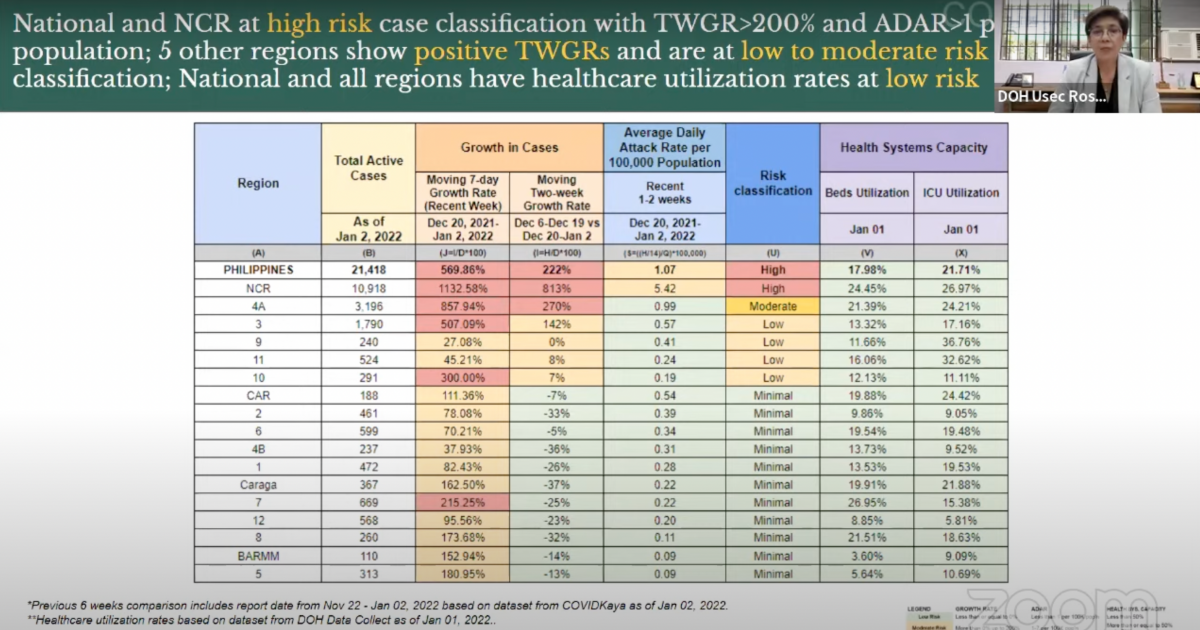Metro Manila, PH now 'high-risk' for COVID-19; hospitals see increase in occupancy rates
The entire Philippines have now been classified as "high-risk" for COVID-19 in light of the recent spike in cases and the threat of a "high probability" of local transmission of the Omicron variant, the Department of Health (DOH) announced on Jan. 3.
“Nationally, we are now at high risk case classification from low risk case the previous week, showing a positive two-week growth rate of 222% and moderate risk average daily attack rate of 1.07 cases per 100,000 individuals,” DOH Undersecretary Maria Rosario Vergeire said in a briefing.
Vergeire said that from Dec. 20, 2021, to Jan. 2, 2022, Metro Manila's average daily attack rate (ADAR), which measures the number of those who get ill after exposure, is now at 5.42 per 100,000 population. Nationwide ADAR, meanwhile, stood at 1.07.

Vergeire's presentation showed that of the country's reported total active cases of at least 21,400 as of Jan. 2, Metro Manila accounts for around 10,900 of the figure.
Calabarzon is at "moderate" risk, with an ADAR of 0.99, while the rest of the regions are either "low" or "minimal" risk, with ADARs below 0.60.
NCR positivity rate spikes even higher to 28%. I now expect the same range of new cases as yesterday. Possibly 3500 to 4000 in PH and 2500 to 3000 in NCR. Please wear your masks. @dzbb @dzrhnews @DZAR1026 @NewsRmn @allangatus @News5PH @dzme_1530khz @dwiz882 @ABSCBNNews @EagleNews pic.twitter.com/yI6Ro8AVwB
— Dr. Guido David (@iamguidodavid) January 1, 2022
On Jan. 1, Guido David of the independent pandemic monitor OCTA Research Group already identified Metro Manila as "high risk", citing its positivity rate, or the number of COVID-19 test results that turned out positive, already surpassing 28%.
Hospital occupancy
Metro Manila has also been seeing a rise in hospitalization rates since the holiday rush.
The country's two main COVID-19 hospitals - Philippine General Hospital in Manila and Dr. Jose N. Rodriguez Memorial Hospital in Caloocan - have reported increasing number of positive patients since the holiday season. | @mjaysoncayabyab
— The Philippine Star (@PhilippineStar) January 3, 2022
Philippine General Hospital (PGH) on Jan. 2 reported that it has already admitted 116 COVID-19 patients, a four-fold increase from its 30 cases on Christmas Day and 85 cases on New Year's Eve.
PGH spokesman Dr. Jonas Del Rosario told DZMM that they've been accepting an average of 10 to 15 COVID-19 patients daily in the past three days.
In Dr. Jose N. Rodriguez Memorial Hospital in Caloocan, meanwhile, medical chief Dr. Alfonso Famaran Jr. said they have 104 positive patients, from 25 last Christmas. Some 30 more patients are awaiting admission.
Vergeire, however, said healthcare utilization rate in all regions remains at "low risk." As of Jan. 1, the agency reported that 20.3% of 18,707 isolation beds, 13.7% of 12,018 ward beds, and 21.7% of 3,450 ICU beds in the country have been occupied.
For Metro Manila, 22.6% of 4,646 isolation beds, 26% of 3,699 ward beds, and 27% of 1,242 ICU beds are reportedly occupied.
"Ito pong sitwasyon sa ospital, naririnig niyo naman, tumataas ang mga numero," Vergeire said. "(But) if we'll look at the overall utilization, wala pa naman pong lumalagpas sa 50% capacity across all of the regions in the country."
She also noted that most of the patients admitted are mild to moderate cases. Vergeire advised those who are exhibiting mild symptoms to first explore home treatment to avoid congesting the hospitals.
"Huwag po tayong agad-agad pumunta sa mga (emergency room) ng ospital. Meron po tayong mga telemedicine services," she said. "Pag pumunta tayo sa ospital, kahit mild ang sintomas natin, mas andoon ang risk na baka mahawa pa rin tayo."
Omicron variant
Vergeire said there are now 11 imported cases of the Omicron variant, nine of whom are returning overseas Filipinos and two of whom are foreign nationals.
The country had last confirmed three local Omicron cases, two from Bicol and one from Metro Manila, which Vergeire's presentation showed indicates "high probability... of local transmission."
Vergeire, however, said that the local transmission of Omicron has yet to be confirmed, as the rest of the genome sequencing results are still underway.
"Itong pagtaas po ng kaso, halo-halo itong factors...we need to be very definite to confirm na talagang Omicron ay andiyan sa komunidad," Vergeire said. "Pero based on observation sa ngayon, ang assumption natin ay andiyan na siya sa community because we've seen a sudden increase in the number of cases," Vergeire said.
For the meantime, Vergeire is attributing the spike in recent cases to the holiday mobility and "reduced" compliance to protocols.
Vergeire also reiterated that under Alert Level 3, the usage of face shields in public spaces remains voluntary.
"Pero syempre, pag-uusapan pa rin po iyan based sa recommendation ng ating experts," she added.
The Philippines will remain under Alert Level 3 until Jan. 15 in a bid to arrest the significant increase in cases. Last Jan. 2 saw 4,600 COVID-19 cases, the highest since Oct. 24, 2021.
Starting on Jan. 3, the Metropolitan Manila Development Authority has also mandated unvaccinated individuals in the capital to stay at home unless it's for essential travel.


